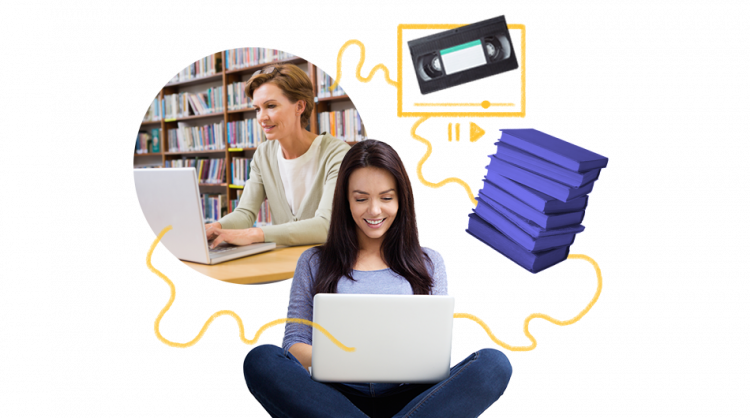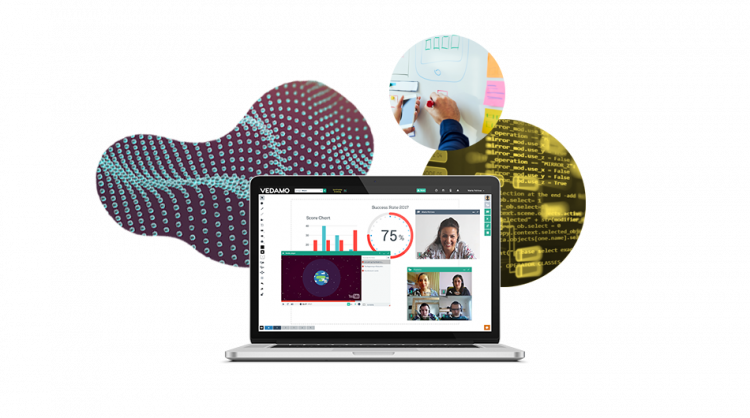The use of digital technologies has dynamically changed educational theory and practice. This has led to the emergence of diverse distance learning solutions. Moreover, it has required the adoption of new methods and approaches to teaching and learning. Teachers are facing the challenge of trying to stay up to date on the evolution of technology and making the best use of it, about teaching and learning in a virtual classroom.
The other side of this process involves public opinion about online education. Getting used to novelties, understanding their benefits, and developing relevant skills to adopt them requires time and effort. People are not always open to trying new things because they never really know what to expect. Learning and adopting something new can be daunting because people tend to want to get things right immediately, which is almost impossible.
In order to effectively use something that is new – no matter if it is a language, skill, device, or distance learning solution – you need some time to identify the ways that it will and won’t work, as well as to make mistakes and deal with them. Once we take this first step of facing the challenges of the unknown and using our experience to get better, many new possibilities arise. Until then, we just stay in our comfort zone, listening to the myths that tell us why the new thing is not for us.

Virtual classrooms have immense opportunities for growth in the field of education. In recent years they have been rapidly evolving and have the potential to exceed the traditional classroom experience. However, they are still considered to be just a mediocre online replica of the physical classroom, and there are still many misconceptions about their effectiveness, quality, and benefits.
Let’s take a look at five of the most common myths about teaching and learning in a virtual classroom, debunk them, and recognize the full benefits of online learning. Here are the 5 myths about teaching and learning in a virtual classroom:
Myth 1: Learning in a virtual classroom limits social interaction
Virtual learning happens through a computer, which socially isolates the learners.
The virtual classroom is a solution that actually brings social aspects to online education. Synchronous online learning is based on the real-time interaction and collaboration between the participants. It allows for immediate feedback, an exchange of opinions, and an active contribution to the learning process. This enhances interactivity and builds a sense of community.
In addition, virtual classrooms allow for interactions between learners of different social groups and geographic locations. This diversity of the participants means that a wide range of individual perspectives will be represented in the collaborative learning process. This makes the learning environment even more social.
The interactions in the virtual classroom are more informal due to the comfort of the well-known (often home) environment while participating in the training. Therefore, learners can overcome stress and minimize the time for social adaptation in the group much more easily and quickly. Communication barriers with both the teacher and other learners can also be rapidly eliminated.
Myth 2: The lack of physical contact leads to a lower quality of training
The virtual teacher is remote and is not able to respond to their students’ reactions, which makes learning less efficient.

Although they are not in one and the same physical room, the participants in the virtual classroom are in a shared environment and can hear and see each other. The teacher can see on their laptop both the learning content, as well as all of the students’ video screens simultaneously. Thus, they can easily follow the learners’ facial expressions, reactions, and progress. This is not possible in a traditional classroom where the whiteboard is in the front of the class and the students are distributed all over the room.
We have already mentioned that usually the participants feel more relaxed when studying from their own homes and that they overcome communication barriers much faster. Thus, they can easily dive into the learning process and actively contribute to the collaborative activities that are taking place. In addition, their participation is much more focused because of the absence of the usual physical distractions from the conventional classroom.
Monitoring is another crucial factor that ensures a high quality of training. Some virtual classrooms have the option for real-time monitoring by hidden observers, as well as for recording and archiving live sessions. This allows for both the analysis and external control of teaching and learning, which is necessary in order to improve the quality of both the learning process and the teacher’s performance.
Myth 3: The teacher is remote and does not have any control over the students’ activities.
The virtual teacher is not able to control what participants are doing in the virtual classroom because they are in remote locations.

Actually, in the virtual classroom the teacher has better control over the group interaction. In the traditional classroom, placing students in groups and giving them instructions does not mean collaboration will naturally happen. In the virtual classroom the teacher has visual control over all of the participants simultaneously, which is not possible in the conventional environment. Each participant sees the video screen not only of the teacher and the other learners, but also their own. Looking at your own expression and behavior leads to increased self-control and discipline.
In advanced virtual classroom sessions, the instructor can allow and deny student access to the different features both on an individual or a group level; for example, the teacher can turn on and off the videoconference connection, allow or deny writing, uploading files, editing objects, assigning a presenter role, etc. This allows for better coordination of group interaction so that each participant contributes equally to the task.
Myth 4: The most important factor when teaching in a virtual classroom is the technology
Efficient online learning depends on the technology used, rather than on the skills and knowledge of the teacher.
The UI and UX are very important, but the technology is just a means for teaching and learning. The technology itself cannot plan and conduct an online session. However, the tools and features are important for the teacher to be able to do their work seamlessly. They should be intuitive so that the teacher will not have to waste time focusing on which button to press and miss out on the group interaction.

In addition, а recent study shows that when teachers see the potential of digital technologies and are willing to use them to enhance learning, they are able to make the best use of poor technological learning environments. The design of the learning activities, classroom management, feedback, and progress assessment are done by the teacher and not by the technology. That is why the teacher‘s charisma and skills to plan the session, prepare content, and engage the learners are the key factors for efficient online learning.
Myth 5: The tutor must train the students on how to work with the virtual classroom, which takes additional time and effort.
The students must complete a special training for using the virtual classroom before the beginning of the actual learning process.
To some extent, this depends on the virtual classroom’s interface and usability. It is good to prepare some instructions for the students on how to access, log in to, and enter the virtual classroom, but it is not necessary to conduct a special training for this. It is enough to write down some instructions with screenshots and minimal technical requirements or record a short video tutorial and send them to the students a few days before the training.
Participants in the virtual classroom can communicate directly with one another, so the teacher can instruct them on which tools to use and explain how to use them. Once the students start using a certain tool, they will easily find it the next time. In the first few sessions the teacher will guide the participants in the environment. After some time, they will naturally get used to it and will quickly start picking up the right tool without the need for instructions.

